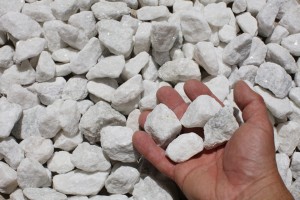When landscaping, there are many options available to those looking to spruce up their yards. One common dilemma is whether to use stone or mulch in non-lawn areas. Both come in an array of styles and colors and have benefits to both gardening and the yard’s aesthetics. For example, both rock and mulch areas tend to inhibit weeds, reducing maintenance needs. However, there are some differences, other than mere appearances, that should be considered to pick the perfect material for your project.

New York White Marble
Stone
Stone in the form of rocks or gravel can be a great way to enhance a garden space or landscape around structures in the yard. Stone will not change or decompose, so there is no need to replace these materials after install, which saves money and effort over time. Rocks are also immune to fire, making stone a great choice when landscaping around a fire pit or in an area prone to wildfires. These materials are also very weather resistant, which can help reduce erosion from wind and rain. This resistance to moisture is also worth considering when planning around a swimming pool or hot tub.
There are a few potential drawbacks when choosing stone for a project, especially with regards to plants. Rocks are typically more basic than acidic and can pass this on to the soil, while many plants prefer more acidity in the soil. Lighter rocks in particular may reflect more heat into the soil, which some plants may not tolerate well.

Eastern Red Cedar Mulch
Mulch
On the other hand, mulch has several benefits to plant growth. Bark mulch and other wood-based items are made up of organic materials which break down over time and add nutrients to the soil. Mulches can be of significant help in maintaining the soil, as they tend to keep the temperature relatively steady and reduce evaporation, helping protect plants from drought and reducing the need to water.
There are some things to consider when working with mulch. As mentioned above, organic materials decompose, which while good for the plants, means replacement mulch will need to be applied every year or so. How and when the mulch is applied is also important. Applying too early may keep the soil cooler longer and delay plant growth. Bark mulch should be applied to a depth of around three inches to help prevent weeds, but too much can stress plants. This makes it important to use the correct amount when landscaping. Fortunately, our website calculators make it easy to determine the amounts of stone, mulch, and dirt needed for any project.
Both stone and bark mulch can be excellent tools when planning an outdoor space. Choosing the option that best meets your needs will give you a solid foundation for current and future projects. Whether hosting backyard barbecues or just enjoying a quiet day outside, these features can help create a beautiful space of which you can be proud.
Call the Mulch Experts at Melvin Mulch at 414-856-9077. They can help you decide which mulch is best for your garden or landscape.
See also “Is Bark or Stone Mulch Better Protection for You?” and “Stone Mulch vs. Bark Mulch: Which to use in your Landscaping Project?“